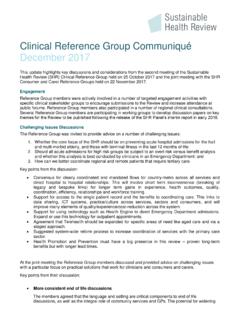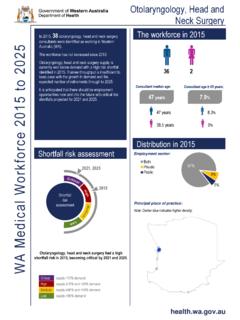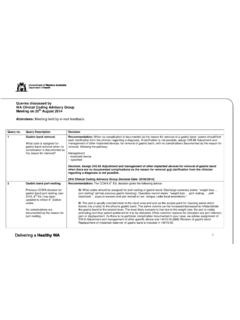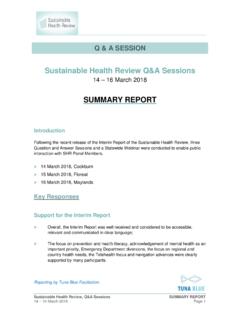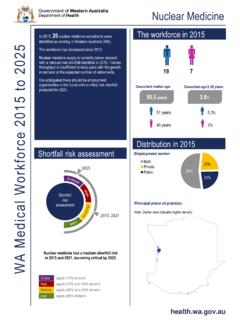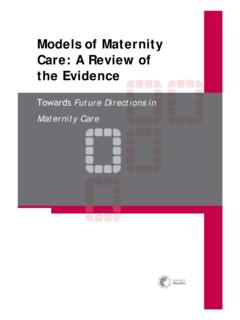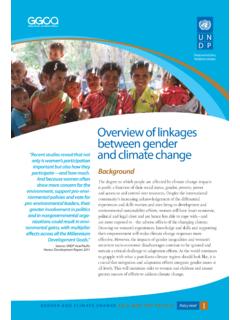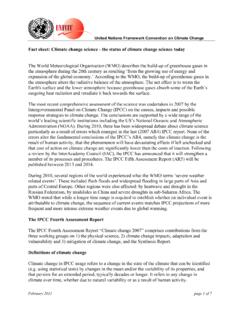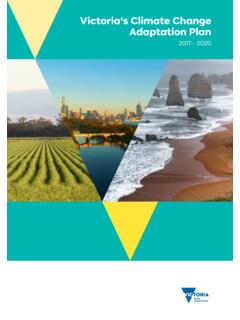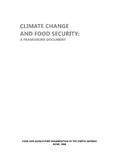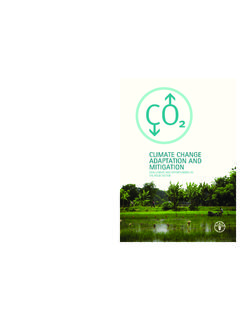Transcription of Health impacts of climate change - ww2.health.wa.gov.au
1 Produced by Environmental Health Directorate Department of Health 2008HP10444 JAN 08 22360 Health impacts of climate change : Adaptation strategies for western AustraliaThis document has been produced to provide an understanding of the potential Health impacts and associated social implications of climate change that may affect the people of western Australia in the future. It has been based on the limited knowledge of the climatic changes that may affect western Australia and provides a starting position for future assessments. The information can contribute towards the development of policies and planning by the Government of western Australia for community adaptations to climate Department of Health acknowledges the expertise and input of the individuals and sectors committed to addressing the potential impacts to public Health and wellbeing from climate change who contributed to the investigations and outcomes presented in this document.
2 These participants are listed in Appendix document was prepared by Jeff Spickett, Helen Brown and Dianne strategies for western A ustralia1 Table of contentsExecutive summary 41. Introduction 52. The assessment process 63. climate change in wA 74. Health impacts Vulnerability Adaptive capacity 105. The project Phase one: identification of Health impacts Phase two: risk assessment and management 206. Prioritisation of adaptation responses 547. Discussion and conclusions 59 Bibliography 61 Glossary 63 Appendix one: Checklist for identification of potential impacts 66 Appendix two: Risk assessment process 68 Appendix three: Participants and reviewers 70 Health impacts of climate change :2 Table of contents - figuresfigure 1: Examples of potential direct and indirect Health impacts of temperature increase in 2030.
3 9figure 2: Components of vulnerability 10figure 3: Adaptive capacity and coping capacity 10figure 4: Common aspects of vulnerability 17figure 5: Health impact pathway opportunities for adaptation 29figure 6: climate change and coping capacity 30 Table of contents - TablesTable 1: Potential Health impacts of extreme events 12 Table 2: Potential Health impacts of gradual climatic changes 13 Table 3: Current responses and limitations 18 Table 4: Consequence ratings 21 Table 5: Likelihood ratings 22 Table 6: Risk priority matrix 22 Table 7: Health impacts with clear climate - Health relationships 23 Table 8: Indirect Health impacts with complex climate - Health relationships 26 Table 9a: Key component 1 - Health impacts of extreme events: tropical cyclones, storms, floods, bushfires 32 Table 9b: Health impacts of extreme events: research/information requirements 34 Table 10a: Key component 2 - Health impacts of temperature related changes: heat events, increased temperature 35 Table 10b: Health impacts of temperature related changes: research/information requirements 38 Table 11a: Key component 3 - water-borne diseases and water quality.
4 Contaminated drinking water from extreme events, exposure to pathogens in recreational water, grey-water and potable water 38 Table 11b: water-borne diseases and water quality: research/information requirements 41 Table 12a: Key component 4 - vector-borne diseases: RRv, Bfv, Dengue, MVE, Malaria, rodent-borne, tick-borne and others 42 Adaptation strategies for western A ustralia3 Table 12b: Vector-borne diseases: research/information requirements 44 Table 13a: Key component 5 - air quality and associated Health impacts : respiratory illnesses, asthma, allergies, UV radiation, VOC exposure, legionnaires disease 45 Table 13b: Air quality and associated Health impacts : research/information requirements 47 Table 14a: Key component 6 - food-borne disease: food poisoning, seafood poisoning, mycotoxins 47 Table 14b: food-borne disease research/information requirements 49 Table 15a: Key component 7 - food production: prices and availability - fall in quality of diet, imported food Health risks 49 Table 15b: food production: research/information requirements 51 Table 16a.
5 Key component 8 - social/community/lifestyle - dislocation, mental Health 51 Table 16b: Social/community/lifestyle: research/information requirements 53 Table 17: Risk ranking summary 54 Table 18: Management actions for risk priorities 55 Table 19a: General principles and adaptation measures 56 Table19b: General principles and adaptation measures research/information requirements 58 Health impacts of climate change :4 Executive summaryIt has been demonstrated that the Earth is warming and climatic parameters are changing. In western Australia, the south west has been experiencing rainfall reductions for several decades and other areas across the State have experienced droughts and atypical events.
6 It is now generally accepted that western Australia will experience a climate in the near future that is drier, hotter and has more extreme weather events than it had in the past. The trends in climatic change will impact human populations through their effects on the physical and biological components of the environment. Global efforts are being made to mitigate climate change and reduce greenhouse gas emissions. However it has been accepted that some change will occur and that individuals and communities will need to adapt to these changed environmental circumstances to avoid adverse consequences. Of significance are the potential Health impacts on people in western Australia.
7 The severity of possible impacts on communities will be dependent on our ability to adapt to situations and environments that may be quite different from those we have Department of Health and the world Health Organisation Collaborating Centre for Environmental Health Impact Assessment at Curtin University recognised that the Health Impact Assessment process provides an appropriate means by which the potential impacts of climate change in wA can be initially assessed. A Health Impact Assessment of climate change Project was undertaken in collaboration with Government and other stakeholders to consider the implications of climate change on the Health of the people of western Australia and to develop a range of adaptive responses to provide Government with the basis for future decision making.
8 The Project was undertaken in two phases. Phase One was the identification of the potential Health impacts that could arise given a particular set of climatic situations in the future, consideration of our current coping capacity and identification of Health related vulnerabilities of people, regions, infrastructure and the economy to specific climatic and environmental events. The second phase entailed a risk assessment of the Health impacts on communities including specific reference to vulnerability, and the development of adaptations which could be used to mitigate the identified impacts . It was recognised that the lack of detailed knowledge of future climatic conditions in western Australia, the future distribution and densities of populations and the development of associated infrastructure did not allow for a comprehensive and quantitative assessment of Health impacts .
9 What emerged from this project, however, was a good understanding of current activities, their adequacy with respect to Health and a range of adaptations and required supporting research. The outcomes have been designed to provide a proactive approach to the protection of the Health of communities in western Australia from any adverse environmental impacts associated with climate change . They form the basis for future planning and decision making by Governments and other relevant sectors and adaptive responses that can be taken up by society in western Australia. Adaptation strategies for western A ustralia51.
10 IntroductionThe evidence is growing that the Earth is warming and that future global climatic and environmental circumstances may be significantly different if appropriate mitigation and abatement programmes are not implemented. Studies have indicated that the rate of warming may not be slowed sufficiently to minimise predicted climatic changes. A consequence of global warming is that changes to physical and biological systems will have impacts on human populations and that people and communities will have to adapt to these potential changes to avoid adverse consequences. In western Australia (wA) it is now generally accepted that in the near future, we will experience a climate that is drier and hotter in the south west with more extreme weather events and more variable in the north west.
